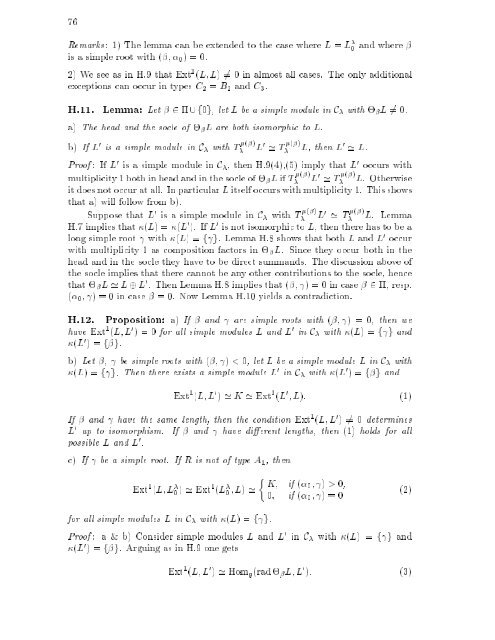subregular nilpotent representations of lie algebras in prime ...
subregular nilpotent representations of lie algebras in prime ...
subregular nilpotent representations of lie algebras in prime ...
Create successful ePaper yourself
Turn your PDF publications into a flip-book with our unique Google optimized e-Paper software.
76<br />
Remarks: 1) The lemma can be extended to the case where L = L 0 and where<br />
is a simple root with ( ; 0) =0.<br />
2) We see as <strong>in</strong> H.9 that Ext 1 (L; L) 6= 0 <strong>in</strong> almost all cases. The only additional<br />
exceptions can occur <strong>in</strong> types C2 = B2 and C3.<br />
H.11. Lemma: Let 2 [f0g, letL be a simple module <strong>in</strong> C with L 6= 0.<br />
a) The head and the socle <strong>of</strong> L are both isomorphic to L.<br />
b) If L 0 is a simple module <strong>in</strong> C with T ( ) L 0 ' T ( ) L, then L 0 ' L.<br />
Pro<strong>of</strong> :IfL 0 is a simple module <strong>in</strong> C , then H.9(4),(5) imply that L 0 occurs with<br />
multiplicity 1 both <strong>in</strong> head and <strong>in</strong> the socle <strong>of</strong> L if T ( ) L 0 ' T ( ) L. Otherwise<br />
it does not occur at all. In particular L itself occurs with multiplicity 1. This shows<br />
that a) will follow from b).<br />
Suppose that L 0 is a simple module <strong>in</strong> C with T ( ) L 0 ' T ( ) L. Lemma<br />
H.7 imp<strong>lie</strong>s that (L) = (L 0 ). If L 0 is not isomorphic to L, then there has to be a<br />
long simple root with (L) =f g. Lemma H.8 shows that both L and L 0 occur<br />
with multiplicity 1 as composition factors <strong>in</strong> L. S<strong>in</strong>ce they occur both <strong>in</strong> the<br />
head and <strong>in</strong> the socle they have to be direct summands. The discussion above <strong>of</strong><br />
the socle imp<strong>lie</strong>s that there cannot be any other contributions to the socle, hence<br />
that L ' L L 0 . Then Lemma H.8 imp<strong>lie</strong>s that ( ; ) = 0 <strong>in</strong> case 2 , resp.<br />
( 0; ) = 0 <strong>in</strong> case =0. Now Lemma H.10 yields a contradiction.<br />
H.12. Proposition: a) If and are simple roots with ( ; )=0, then we<br />
have Ext 1 (L; L 0 )=0for all simple modules L and L 0 <strong>in</strong> C with (L) =f g and<br />
(L 0 )=f g.<br />
b) Let , be simple roots with ( ; ) < 0, letL be asimplemodule L <strong>in</strong> C with<br />
(L) =f g. Then there exists a simple module L 0 <strong>in</strong> C with (L 0 )=f g and<br />
Ext 1 (L; L 0 ) ' K ' Ext 1 (L 0 ;L): (1)<br />
If and have the same length, then the condition Ext 1 (L; L 0 ) 6= 0determ<strong>in</strong>es<br />
L 0 up to isomorphism. If and have di erent lengths, then (1) holds for all<br />
possible L and L 0 .<br />
c) If be a simple root. If R is not <strong>of</strong> type A1, then<br />
Ext 1 (L; L 0 ) ' Ext 1 (L 0 ;L) ' K; if ( 0; ) > 0,<br />
0; if ( 0; )=0<br />
for all simple modules L <strong>in</strong> C with (L) =f g.<br />
Pro<strong>of</strong> : a & b) Consider simple modules L and L 0 <strong>in</strong> C with (L) =f g and<br />
(L 0 )=f g. Argu<strong>in</strong>g as <strong>in</strong> H.9 one gets<br />
Ext 1 (L; L 0 ) ' Homg(rad L; L 0 ): (3)<br />
(2)

















